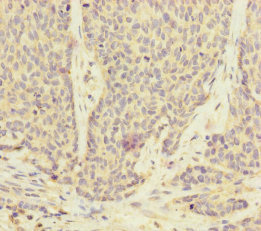-
货号:CSB-PA025409ESR1HU
-
规格:¥440
-
促销:
-
图片:
-
Western blot
All lanes: UACA antibody at 5.51µg/ml
Lane 1: Hela whole cell lysate
Lane 2: A549 whole cell lysate
Lane 3: Jurkat whole cell lysate
Secondary
Goat polyclonal to rabbit IgG at 1/10000 dilution
Predicted band size: 163, 162 kDa
Observed band size: 163, 140 kDa -
Immunohistochemistry of paraffin-embedded human ovarian cancer using CSB-PA025409ESR1HU at dilution of 1:100
-
-
其他:
产品详情
-
产品描述:
CUSABIO uses the recombinant human uveal autoantigen with coiled-coil domains and ankyrin repeats (UACA) protein (1-90AA) to immunize rabbits to obtain anti-serum, which is antigen affinity purified to get the UACA polyclonal antibody. This UACA antibody exists as an unconjugated IgG. It only shows reactivity with human UACA protein. And it has been validated for use in ELISA, WB, and IHC applications. The target protein UACA regulates APAF1 expression and plays an important role in the regulation of stress-induced apoptosis.
-
产品名称:Rabbit anti-Homo sapiens (Human) UACA Polyclonal antibody
-
Uniprot No.:Q9BZF9
-
基因名:UACA
-
别名:FLJ10128 antibody; KIAA1561 antibody; MGC141967 antibody; MGC141969 antibody; Nuclear membrane binding protein antibody; NUCLING antibody; UACA antibody; UACA_HUMAN antibody; Uveal autoantigen with coiled coil domains and ankyrin repeats antibody; Uveal autoantigen with coiled-coil domains and ankyrin repeats antibody
-
宿主:Rabbit
-
反应种属:Human
-
免疫原:Recombinant Human Uveal autoantigen with coiled-coil domains and ankyrin repeats protein (1-90AA)
-
免疫原种属:Homo sapiens (Human)
-
标记方式:Non-conjugated
-
克隆类型:Polyclonal
-
抗体亚型:IgG
-
纯化方式:Antigen Affinity Purified
-
浓度:It differs from different batches. Please contact us to confirm it.
-
保存缓冲液:PBS with 0.02% sodium azide, 50% glycerol, pH7.3.
-
产品提供形式:Liquid
-
应用范围:ELISA, WB, IHC
-
推荐稀释比:
Application Recommended Dilution WB 1:1000-1:5000 IHC 1:20-1:200 -
Protocols:
-
储存条件:Upon receipt, store at -20°C or -80°C. Avoid repeated freeze.
-
货期:Basically, we can dispatch the products out in 1-3 working days after receiving your orders. Delivery time maybe differs from different purchasing way or location, please kindly consult your local distributors for specific delivery time.
引用文献
- Serum Sp17 Autoantibody Serves as a Potential Specific Biomarker in Patients with SAPHO Syndrome H You,Journal of Clinical Immunology,2021
相关产品
靶点详情
-
功能:Regulates APAF1 expression and plays an important role in the regulation of stress-induced apoptosis. Promotes apoptosis by regulating three pathways, apoptosome up-regulation, LGALS3/galectin-3 down-regulation and NF-kappa-B inactivation. Regulates the redistribution of APAF1 into the nucleus after proapoptotic stress. Down-regulates the expression of LGALS3 by inhibiting NFKB1.; Modulates isoactin dynamics to regulate the morphological alterations required for cell growth and motility. Interaction with ARF6 may modulate cell shape and motility after injury. May be involved in multiple neurite formation.
-
基因功能参考文献:
- Lycopene inhibits RCAN1-mediated apoptosis by reducing ROS levels and by inhibiting NF-kappaB activation, Nucling induction, and the increase in apoptotic indices in neuronal cells. PMID: 27928873
- The down-regulation of APIP and UACA expression suggests that the threshold to activate the apoptosome apparatus may be decreased in non-small cell lung cancer cells. PMID: 22407486
- UACA is a novel candidate for eye muscle autoantigens in thyroid-associated ophthalmopathy PMID: 15358194
-
亚细胞定位:Nucleus. Cytoplasm. Cytoplasm, cytoskeleton. Note=Expressed diffusely in cytoplasm.
-
组织特异性:Highly expressed in skeletal muscle, heart, kidney and pancreas. Expressed in choroid, retina and epidermal melanocytes. Expressed in eye muscles and thyroid follicular cells.
-
数据库链接:
HGNC: 15947
OMIM: 612516
KEGG: hsa:55075
STRING: 9606.ENSP00000314556
UniGene: Hs.108049
Most popular with customers
-
-
YWHAB Recombinant Monoclonal Antibody
Applications: ELISA, WB, IF, FC
Species Reactivity: Human, Mouse, Rat
-
Phospho-YAP1 (S127) Recombinant Monoclonal Antibody
Applications: ELISA, WB, IHC
Species Reactivity: Human
-
-
-
-
-























